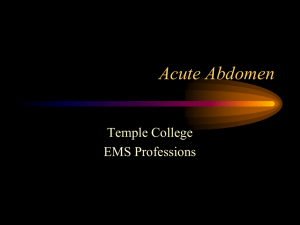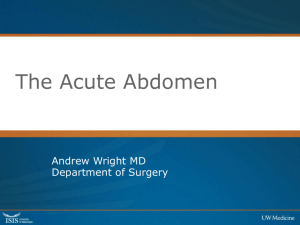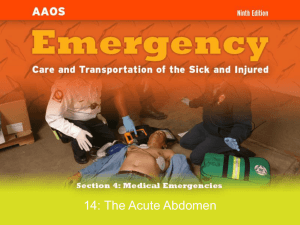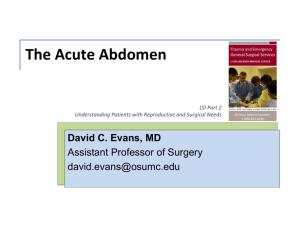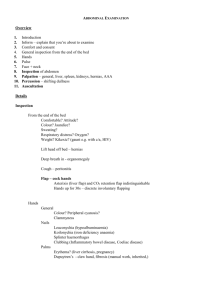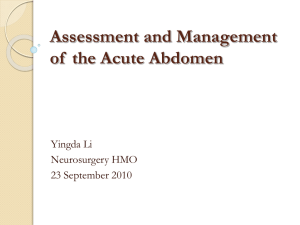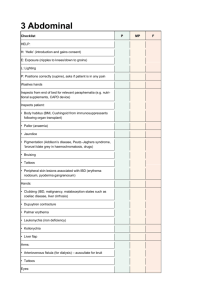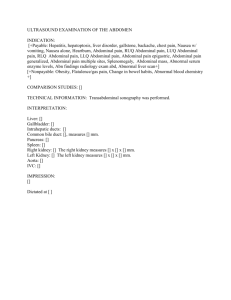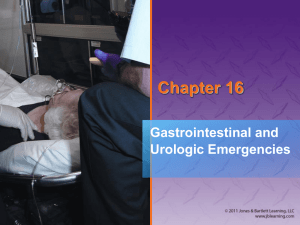Chapter 17
advertisement
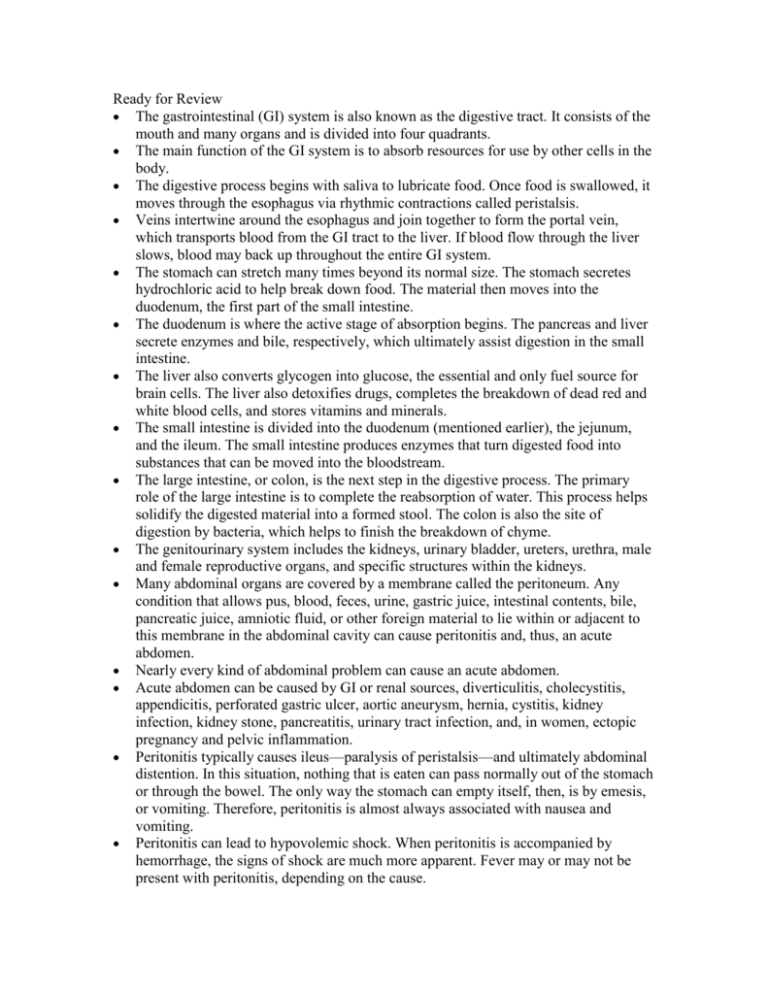
Ready for Review The gastrointestinal (GI) system is also known as the digestive tract. It consists of the mouth and many organs and is divided into four quadrants. The main function of the GI system is to absorb resources for use by other cells in the body. The digestive process begins with saliva to lubricate food. Once food is swallowed, it moves through the esophagus via rhythmic contractions called peristalsis. Veins intertwine around the esophagus and join together to form the portal vein, which transports blood from the GI tract to the liver. If blood flow through the liver slows, blood may back up throughout the entire GI system. The stomach can stretch many times beyond its normal size. The stomach secretes hydrochloric acid to help break down food. The material then moves into the duodenum, the first part of the small intestine. The duodenum is where the active stage of absorption begins. The pancreas and liver secrete enzymes and bile, respectively, which ultimately assist digestion in the small intestine. The liver also converts glycogen into glucose, the essential and only fuel source for brain cells. The liver also detoxifies drugs, completes the breakdown of dead red and white blood cells, and stores vitamins and minerals. The small intestine is divided into the duodenum (mentioned earlier), the jejunum, and the ileum. The small intestine produces enzymes that turn digested food into substances that can be moved into the bloodstream. The large intestine, or colon, is the next step in the digestive process. The primary role of the large intestine is to complete the reabsorption of water. This process helps solidify the digested material into a formed stool. The colon is also the site of digestion by bacteria, which helps to finish the breakdown of chyme. The genitourinary system includes the kidneys, urinary bladder, ureters, urethra, male and female reproductive organs, and specific structures within the kidneys. Many abdominal organs are covered by a membrane called the peritoneum. Any condition that allows pus, blood, feces, urine, gastric juice, intestinal contents, bile, pancreatic juice, amniotic fluid, or other foreign material to lie within or adjacent to this membrane in the abdominal cavity can cause peritonitis and, thus, an acute abdomen. Nearly every kind of abdominal problem can cause an acute abdomen. Acute abdomen can be caused by GI or renal sources, diverticulitis, cholecystitis, appendicitis, perforated gastric ulcer, aortic aneurysm, hernia, cystitis, kidney infection, kidney stone, pancreatitis, urinary tract infection, and, in women, ectopic pregnancy and pelvic inflammation. Peritonitis typically causes ileus—paralysis of peristalsis—and ultimately abdominal distention. In this situation, nothing that is eaten can pass normally out of the stomach or through the bowel. The only way the stomach can empty itself, then, is by emesis, or vomiting. Therefore, peritonitis is almost always associated with nausea and vomiting. Peritonitis can lead to hypovolemic shock. When peritonitis is accompanied by hemorrhage, the signs of shock are much more apparent. Fever may or may not be present with peritonitis, depending on the cause. Symptoms of urinary tract infection include painful urination, frequent urges to urinate, difficulty urinating, and possibly referred pain to the shoulder or neck. The urine may have a foul odor and be cloudy. Kidney stones result when an excess of insoluble salts or uric acid crystallizes in the urine. Symptoms include severe pain in the flank that may migrate forward to the groin. The pain may cause an increased blood pressure and pulse rate. Acute renal failure is a sudden decrease in kidney filtration, resulting in a release of toxins into the blood. Chronic renal failure is progressive and irreversible inadequate kidney function. Gynecologic problems are a common cause of acute abdominal pain. Always consider that a woman with lower abdominal pain and tenderness may have a problem related to her ovaries, fallopian tubes, or uterus. Abdominal pain may stem from other organ systems. If an abdominal aortic aneurysm ruptures, massive hemorrhage may occur and signs of acute peritoneal irritation will present. A hernia (protrusion of an organ or tissue through a hole in the body) may eventually compromise blood supply, causing a serious emergency. Transport patients with an acute abdomen promptly but gently. Remember that GI complaints often involve body substances. Take extra gloves, masks, gowns, and other protective equipment and supplies with you to the scene. In a patient with an acute abdomen, the first priorities are to assess airway, breathing, and circulation and then apply oxygen. Assist ventilation if the patient is breathing inadequately. When taking the patient’s history, ask when the symptoms began, how they have changed, the exact location of the pain, and how it feels. Also ask if there has been vomiting or diarrhea. Remember airway concerns with a patient who is vomiting. Open the airway using the appropriate maneuvers, and closely inspect it for foreign bodies. Remove or suction any obstructions that are found. Abnormal abdominal assessment findings include excessive nausea/vomiting or hematemesis, changes in bowel habits/stool, painful or frequent urination that is discolored or has a strong odor, weight loss, belching/flatulence, concurrent chest pain, and abdominal pain, tenderness, guarding, or distention. Pain is commonly located directly over the inflamed area of the peritoneum, or it may be referred to another part of the body. Referred pain occurs because of the connections between the two different nervous systems supplying the parietal peritoneum and the visceral peritoneum. A healthy or normal abdomen should be soft and not tender. The pain in an acute abdomen may be sharply localized or diffuse and will vary in severity. Localized pain gives a clue to the problem organ or area causing it. The abdominal muscles may have become rigid, called guarding. Take vital signs, and gently palpate the abdomen. If the abdomen is tender, the patient needs to be transported urgently. Note the degree of abdominal distention; this can also provide clues to the severity of the patient’s condition. Patients with acute abdomen may be comfortable only when lying in one particular position, for example curled up on one side or with the right knee drawn up. Note the patient’s position. Do not give the patient with an acute abdomen anything by mouth. Establish IV access. Consult with medical control to administer pain medication. Renal dialysis is a procedure for removing toxic wastes and excess fluids from the blood. Patients receiving dialysis usually have a shunt through which they are connected to the dialysis machine. They are vulnerable to problems such as hypotension, potassium imbalance, disequilibrium syndrome, and air embolism.
